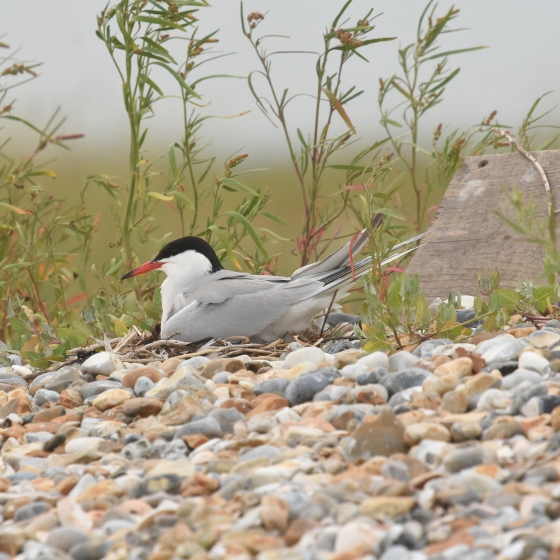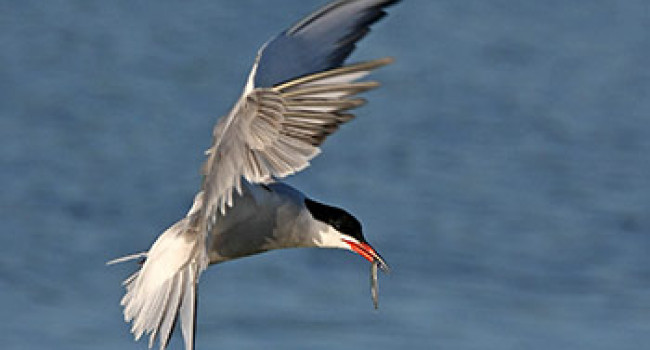Common Tern
Sterna hirundo (Linnaeus, 1758)
CN
 COMTE
COMTE  6150
6150

Family: Charadriiformes > Laridae

This summer visitor to Britain & Ireland is the most familiar of our terns thanks to its habit of inland nesting, a behaviour common across part of its wider range but absent in the larger Scottish colonies.
Common Terns arrive from the middle of April, departing again in late summer for wintering grounds that stretch south from the coast of Spain and around Africa's western seaboard.
While the Common Tern's British breeding range has expanded over recent years – thanks to birds occupying inland waterbodies such as flooded gravel bits – these inland colonies tend to be small, and the gains here contrast with losses at the larger coastal colonies.
Exploring the trends for Common Tern
Our Trends Explorer will also give you the latest insight into how the UK's Common Tern population is changing.
trends explorerIdentification
Common Tern identification is often difficult. The following article may help when identifying Common Tern.
SONGS AND CALLS
Listen to example recordings of the main vocalisations of Common Tern, provided by xeno-canto contributors.
Flight call
Call
Song
Develop your bird ID skills with our training courses
Our interactive online courses are a great way to develop your bird identification skills, whether you're new to the hobby or a competent birder looking to hone your abilities.
Browse training coursesStatus and Trends
Population size and trends and patterns of distribution based on BTO surveys and atlases with data collected by BTO volunteers.
CONSERVATION STATUS
This species can be found on the following statutory and conservation listings and schedules.
POPULATION CHANGE
Common Terns breed at lakes and reservoirs scattered across lowland Britain, especially in the major river valleys, and extensively at the coast. There are a few very large coastal colonies and groups of colonies that account for more than half the total population. Breeding numbers and productivity at sample colonies have been monitored annually since 1986 by JNCC's Seabird Monitoring Programme. The abundance trend shows approximate stability from 1986 to 2018 with some small fluctuations, equating to a 9% increase over this period (although this is not statistically significant), while productivity has fluctuated but appears to show a recent decline (SMP data here).
Common Terns are poorly covered by general breeding bird surveys because of their highly aggregated breeding population. There have been enough birds seen on BBS visits for a trend to be drawn but this has an exceptionally wide confidence interval and probably relates mainly to birds seen on overland passage, prospecting for nest sites or breeding in small, dispersed colonies. Extraordinary counts in 2017 and very high counts in 2014 have caused an upturn in the BBS index, but other recent counts have been similar to those from previous years.
Exploring the trends for Common Tern
Our Trends Explorer will also give you the latest insight into how the UK's Common Tern population is changing.
trends explorerDISTRIBUTION
Breeding Common Terns are widespread and primarily coastal in Scotland and are found on the lochs and islands of the west coast, Outer Hebrides, Northern Isles and around the inner Moray Firth. This contrasts with England, where the species’ range is dominated by inland colonies. In Ireland, colonies are more clustered, both on the coast and inland where most nest on islands in the largest lakes.
Occupied 10-km squares in UK
| No. occupied in breeding season | 669 |
| % occupied in breeding season | 22 |
| No. occupied in winter | 15 |
| % occupied in winter | 0.5 |
European Distribution Map
European Breeding Bird Atlas 2
Breeding Season Habitats
| Most frequent in |
Estuaries 
|
DISTRIBUTION CHANGE
The breeding distribution change map shows a clear pattern of losses in Scotland and Ireland contrasting with gains in eastern and central England since both previous breeding atlases.
| % change in range in breeding season (1968–72 to 2008–11) | +11.2% |
SEASONALITY
Common Tern is a summer breeding species, present from April onwards, departing from August onwards.

Movement
Information about movement and migration based on online bird portals (e.g. BirdTrack), Ringing schemes and tracking studies.
An overview of year-round movements for the whole of Europe can be seen on the EuroBirdPortal viewer.
RINGING RECOVERIES
View a summary of recoveries in the Online Ringing Report.
Foreign locations of birds ringed or recovered in Britain & Ireland

Biology
Lifecycle and body size information about Common Tern, including statistics on nesting, eggs and lifespan based on BTO ringing and nest recording data.
PRODUCTIVITY & NESTING
Number of Broods 
|
1 |
Egg Size 
|
41×30 mm Weight = 20.2 g (of which 5% is shell) |
Clutch Size 
|
2–3 eggs | 2.55 ± 0.72 (1–3) N=143 
|
Exploring the trends for Common Tern
Our Trends Explorer will also give you the latest insight into how the UK's Common Tern population is changing.
trends explorerSURVIVAL & LONGEVITY
View number ringed each year in the Online Ringing Report
Maximum Age from Ringing 
|
33 years 0 months 6 days (set in 1996) 
|
Typical Lifespan 
|
12 years with breeding typically at 3 year |
Adult Survival 
|
0.9  
|
Juvenile Survival 
|
0.47 (to age 2) 
|
Exploring the trends for Common Tern
Our Trends Explorer will also give you the latest insight into how the UK's Common Tern population is changing.
trends explorerBIOMETRICS
Wing Length 
|
Adults | 271.2±6.5 | Range 260–281mm, N=304 |
| Juveniles | 261.8±8.6 | Range 247.5-275.5mm, N=120 |
Body Weight 
|
Adults | 128±9.6 | Range 113–144g, N=429 |
| Juveniles | 127±13.7 | Range 106–153g, N=124 |
Feather measurements and photos on featherbase 
CODES & CLASSIFICATION
Ring size 
|
C2 |
Field Codes 
|
2-letter: CN | 5-letter code: COMTE | Euring: 6150 |
For information in another language (where available) click on a linked name
Research
Interpretation and scientific publications about Common Tern from BTO scientists.
CAUSES AND SOLUTIONS
Causes of change
There is little good evidence available regarding the drivers of the breeding population change in this species in the UK.
Further information on causes of change
No further information is available.
Information about conservation actions
The reasons for the declines at coastal colonies are not clear and a wide range of potential conservation actions have been suggested by different authors. These include the control of predators such as rats (Amaral et al. 2010) and gulls (Blokpoel et al. 1997), including selectively controlling chick-predating gulls in Canada (Guillemette & Brousseau 2001); providing plywood shelters for chicks to reduce predation (Burgess & Morris 1992); actions to reduce disturbance such as restricting access to nesting areas (Fasola & Canova 1996) and educating watercraft owners about the effects of disturbance (Burger & Leonard 2000); and habitat management to reduce vegetation (Cook-Haley & Millenbah 2002). In the latter study, vegetation was reduced through spraying and nest success was highest in areas with moderate amounts (40-50%) of vegetation cover.
In Maryland, USA, McGowan et al. (2019) successfully relocated a colony affected by construction work to a new site 200 m away, using a combination of deterrents (overhead lines) at the old site and attractants (audio calls and decoys) at the new site. However, they caution that this approach should only be used when absolutely essential and note that whilst in this case there were no apparent effects on reproduction, this approach may not be viable on all sites.
It is currently unclear which action or actions are most likely to help reverse declines and hence further research may be needed to inform conservation policies. Denac & Bozic (2020) give an account of a wide variety of conservation measures undertaken to provide and enhance breeding habitat for Common Terns in Slovenia, including various actions to manage vegetation, reduce predation and increase nest site availability by preventing Black-headed Gulls from occupying sites (the latter by blocking access until terns had returned using a grid of plastic strings), The success (or failure) of the conservation actions are discussed, although this is largely subjective and the efficacy of the various measures have not been tested experimentally.
Away from coastal sites, the provision of nesting rafts has proved a successful method to attract Common Terns to previously unoccupied inland sites (Dunlop et al. 1991).
Links to more studies from ConservationEvidence.com
- Re-establishment of Atlantic puffins (Fratercula arctica) at a former breeding site in the Gulf of Maine
- Rotator for protecting circular fish ponds against predatory birds
- Breeding ecology and management of snowy plovers in north-central Oklahoma
Read more studies about Common Tern on Conservation Evidence >
Would you like to search for another species?











Share this page